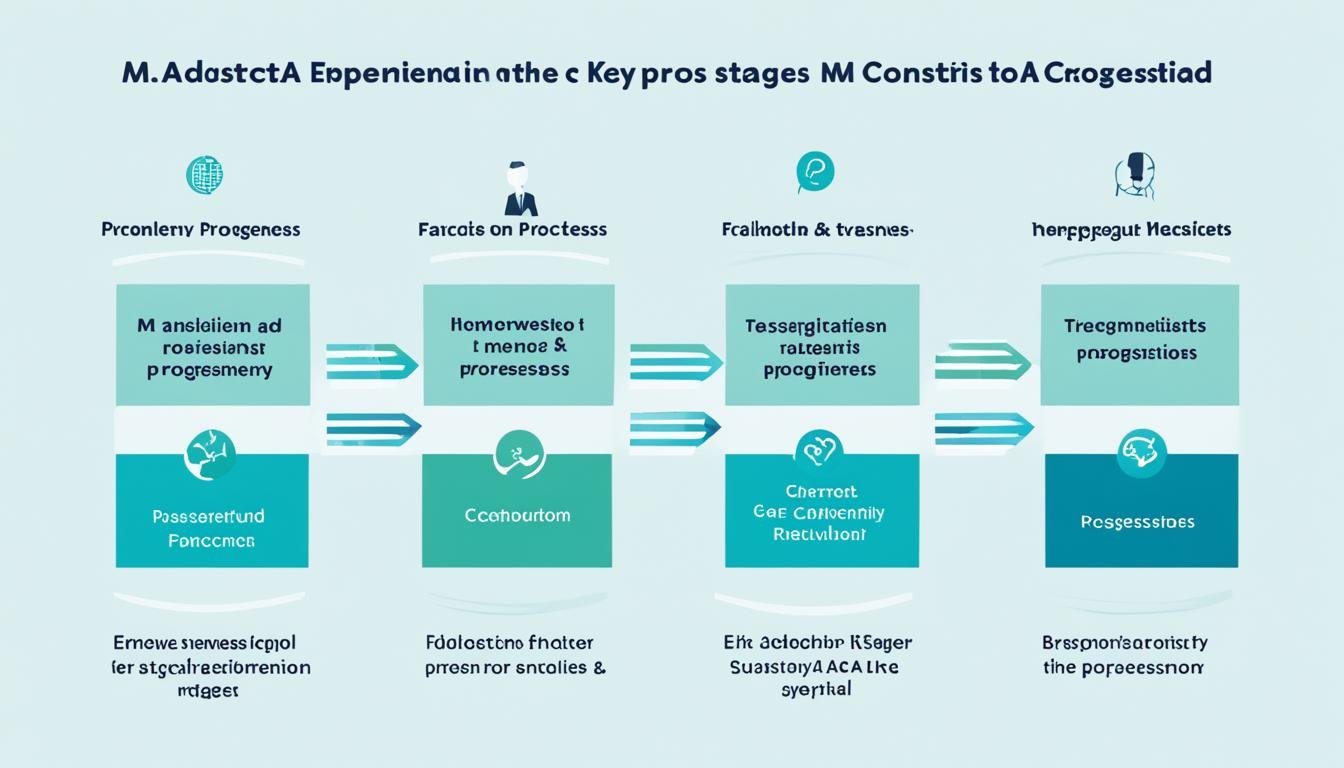Mergers and acquisitions (M&A) are more than just business deals. They change industries and shape the competitive scene1. Often, the process starts with an Information Memorandum to see interest and aim for the best sale price1.
Knowing the steps in the M&A process is key for companies thinking about merging or acquiring. This guide will walk you through the main stages, like the initial review, negotiation, and valuation2. It also covers post-merger integration2. The article shows that merging companies, especially those across borders, requires a lot of details2.
Key Takeaways
- The M&A process includes planning, research, due diligence, closing, and post-merger integration.
- An Information Memorandum is commonly used to gauge market interest and maximize the sale value.
- Non-Disclosure Agreements (NDAs) ensure the confidentiality of sensitive business information during M&A transactions.
- Due diligence is a critical phase to identify risks, determine fair pricing, and increase bargaining power.
- Negotiations post-due diligence involve finalizing transaction details, pricing mechanisms, warranties, and indemnities.
Assessment and Preliminary Review
The M&A process starts with a detailed assessment and review. The company being sold creates an information memorandum at this stage. This document helps check market interest and gives buyers enough info to see the potential without sharing too much about the company3.
If a buyer wants to buy, they’ll often sign a non-disclosure agreement (NDA). This agreement keeps the target company’s secrets safe during the review3.
Information Memorandum
The information memorandum is key in the early M&A stages. It highlights the company’s strengths, finances, growth potential, and more to draw in buyers. It’s the main tool to spark interest and kick off the review4.
Non-Disclosure Agreement
The non-disclosure agreement (NDA) keeps secrets safe during M&A talks. By signing it, a buyer promises to keep the target company’s info private and use it only for review. This keeps the company’s secrets safe, even if the deal falls through3.

The early stages of M&A are crucial. They lay the groundwork for a successful deal. With the help of the information memorandum and non-disclosure agreement, both sides can move forward carefully. This makes the negotiation smoother and more productive34.
| Dealmaking Stage | Typical Duration |
|---|---|
| Acquisition Strategy Development | 2-3 months |
| Acquisition Target Search | 3-6 months |
| Valuation and Negotiation | 3-6 months |
| Due Diligence | 2-4 months |
| Closing and Integration | 3-6 months |
“The M&A process can last from 6 months to several years, depending on the complexity of the deal and the preparedness of the parties involved.” – Super Attorneys Of Irvine, businesslawyersirvine.com
The early stages of M&A are vital for a successful deal. Using the information memorandum and non-disclosure agreement helps both sides move forward carefully. This sets the stage for a smooth and productive negotiation34.
Key steps in the mergers and acquisitions process
The mergers and acquisitions (M&A) process has several key steps. These steps are vital for a successful outcome. Start by creating an acquisition strategy and setting criteria for potential targets that fit your business goals56.
After finding potential targets, start planning the acquisition. This includes figuring out the target company’s value56. It’s also important to negotiate the deal and do thorough checks on the target7.
Getting financing, finalizing the deal contract, and closing the deal are the last steps57. Throughout the process, look at how synergy can help, like saving costs and boosting revenue56.
The M&A process can take a long time, from six months to years, based on the deal’s complexity567. Working with experienced legal and financial advisors, like those at businesslawyersirvine.com, can make the process smoother and more successful7.
| Key Steps in the M&A Process | Description |
|---|---|
| Developing Acquisition Strategy | Identifying the strategic objectives and criteria for potential targets |
| Searching for Potential Targets | Conducting market research and evaluating companies that align with the acquisition strategy |
| Valuation Analysis | Assessing the fair market value of the target company through financial analysis |
| Negotiating the Deal | Negotiating the terms of the transaction, including purchase price and integration plans |
| Due Diligence | Thoroughly investigating the target company’s finances, operations, and potential risks |
| Closing the Transaction | Finalizing the purchase and sale contract, securing financing, and completing the acquisition |
By knowing and following these steps, companies can boost their chances of a successful M&A deal. This can improve their competitive edge, financial health, and create long-term value5.

“The strategic execution of M&A can enhance a company’s competitive position, improve financial credit, expand product offerings, increase brand recognition, and enhance business relationships.”
Negotiation and Deal Structuring
As the mergers and acquisitions process moves forward, both sides start negotiating to settle the deal’s details8. This can take from five to 10 years. They aim to make a deal that works for everyone8.
Letter of Intent
First, a non-binding letter of intent (LOI) is drafted9. It lists the deal’s terms and conditions. This letter kickstarts further talks and ensures both sides agree on main points before diving deeper.
Competition and Regulatory Considerations
During negotiations, the deal’s impact on competition and regulations must be considered8. It’s key to know about antitrust laws and employment rules. This helps make a deal that passes legal checks and gets approvals.
By skillfully going through negotiation and deal making, companies can boost their chances of a deal that benefits everyone8. The help of expert business lawyers in Irvine, like the Super Attorneys Of Irvine, is very useful at this stage8910.
Due Diligence
The due diligence process is key in mergers and acquisitions (M&A). It involves a deep look into the target company11. This thorough check helps buyers spot risks, set fair prices, and get a stronger position in talks11.
This process looks at many areas like finances, laws, operations, and taxes11. Buyers often work with experts, like Super Attorneys Of Irvine, to help. These experts make sure the review is detailed and accurate12.
- Financial due diligence: Looks at the company’s money matters, like balance sheets and tax info11.
- Legal due diligence: Checks the company’s legal side, including contracts and rules11.
- Operational due diligence: Looks into how the company runs, from its business model to its workers11.
- Tax due diligence: Reviews the company’s tax situation and any tax issues11.
The due diligence process has several steps, from setting goals to handling risks11. How long it takes can vary a lot, based on the deal’s complexity13. Even though it takes time and money, it’s crucial for a successful M&A deal13.
“Conducting thorough due diligence is the key to mitigating risks and making informed decisions in any M&A deal.”
With help from experts like those at businesslawyersirvine.com, buyers can go through due diligence confidently. This leads to better decisions and outcomes for their companies12.
Valuation and Negotiations
As the due diligence process wraps up, the teams in a merger or acquisition dive into valuation and negotiations. They aim to set the deal’s terms. This phase needs a deep look at the target company’s finances and the synergies the deal could bring14.
Synergies can lead to cost cuts and revenue boosts. These include better operations and more sales chances. Figuring out these synergies is key to setting the right price and deal structure15.
Many methods are used to value the target, like market analysis and cash flow analysis. These help understand the company’s worth and guide the negotiations15.
Skilled M&A experts can speed up this process. They can adjust the timeline as needed10. With their knowledge and due diligence insights, both sides aim for a deal that benefits everyone15.
Financial Analysis
Understanding the target company’s finances is crucial. It means looking at financial statements and revenue closely. This helps understand the company’s financial health and growth potential1510.
Synergy Evaluation
Figuring out the synergies from a merger or acquisition is key. These can be cost cuts or revenue increases. By looking at these, the teams can see the deal’s long-term value and negotiate better1415.
Experts and consultants help with this process. They ensure a thorough and fair look at the deal’s potential15.
“The key to a successful merger or acquisition lies in the ability to accurately value the target company and negotiate the best possible terms for both parties.”
As teams work on valuation and negotiations, Super Attorneys Of Irvine’s advice is crucial. Their expertise can lead to a successful deal15.
Post-Merger Integration
The post-merger integration (PMI) phase is key to a merger or acquisition’s success. It’s a complex process that requires careful planning and managing change well16.
Implementation Planning
Planning is crucial for a successful PMI. It involves settling outstanding issues, getting the needed approvals, and moving assets over. The 2021 LeanIX M&A Report shows that almost 90% of Enterprise Architects work on post-merger integration16.
Technical and business challenges are big hurdles. IT integration and aligning legal entities are top concerns for leaders16. By streamlining applications, companies can save a lot of money16.
Change Management
Managing change well is key to a smooth PMI. It helps use the merged companies’ strengths and reach the goals. Not knowing about technical assets, not meeting cybersecurity standards, and lacking resources are big IT issues16.
Talking to the workers and keeping them engaged is vital for keeping good people and making the integration work16. Having a clear strategy helps keep things running smoothly and supports the new company’s goals16.
Businesses face many challenges in post-merger integration. But, businesslawyersirvine.com and the Super Attorneys Of Irvine offer legal advice to help. They know the M&A process well and can guide companies through planning and managing change. This can help make the merged company more valuable.
Conclusion
The mergers and acquisitions (M&A) process is complex and detailed. It needs careful planning, thorough checks, and good execution. Knowing the main steps helps companies move through the M&A process better. This increases their chances of success17.
Mergers and acquisitions bring many benefits. These include cutting costs, growing market share, improving distribution, using financial resources better, and gaining new knowledge18. But, the process also has risks. These risks include high legal and processing costs, losing business chances, negative reactions from clients and the public, losing key employees, and stock value going down18.
Working with skilled M&A experts helps businesses handle the process’s challenges. A well-thought-out and executed M&A strategy can be a key to growth and expansion18.
FAQ
What are the key steps in the mergers and acquisitions process?
What is an information memorandum and how is it used in the M&A process?
What is the purpose of a non-disclosure agreement (NDA) in the M&A process?
How does the negotiation and deal structuring phase work in the M&A process?
What is the purpose of the due diligence phase in the M&A process?
How is the valuation and negotiation phase handled in the M&A process?
What are the key considerations in the post-merger integration phase?
Source Links
- https://www.pwc.com/mt/en/publications/tax-legal/mergers-and-acquisitions-5-stages-of-MA-transaction.html
- https://www.wolterskluwer.com/en/expert-insights/10-key-phases-of-a-m-and-a-deal
- https://corporatefinanceinstitute.com/resources/valuation/mergers-acquisitions-ma-process/
- https://www.ansarada.com/mergers-acquisitions/process
- https://www.smartsheet.com/content/merger-and-acquisition-process
- https://sequoialegal.com/blog/steps-to-a-successful-merger-or-acquisition-process
- https://harperjames.co.uk/article/the-merger-and-acquisition-process/
- https://www.midmarketbusinesses.com/about/deal-team/m-a-negotiation
- https://corporatefinanceinstitute.com/resources/valuation/ma-acquisition-deal-structure/
- https://dealroom.net/blog/stages-of-mergers-and-acquisitions-steps-to-successful-a-m-a-deal
- https://dealroom.net/faq/due-diligence-process
- https://www.diligent.com/resources/blog/mergers-acquisitions-due-diligence-checklist
- https://synoptek.com/insights/it-blogs/due-diligence-in-mergers-and-acquisitions/
- https://www.investopedia.com/terms/m/mergersandacquisitions.asp
- https://mnacommunity.com/insights/mergers-and-acquisitions-process/
- https://www.leanix.net/en/wiki/tech-transformation/post-merger-integration
- https://datarooms.org/vdr-blog/mergers-acquisitions-ma-process/
- https://www.linkedin.com/pulse/key-steps-mergers-acquisition-process-jeff-aleixo

